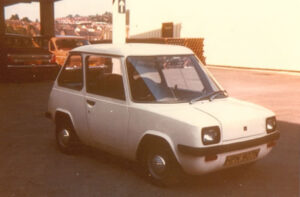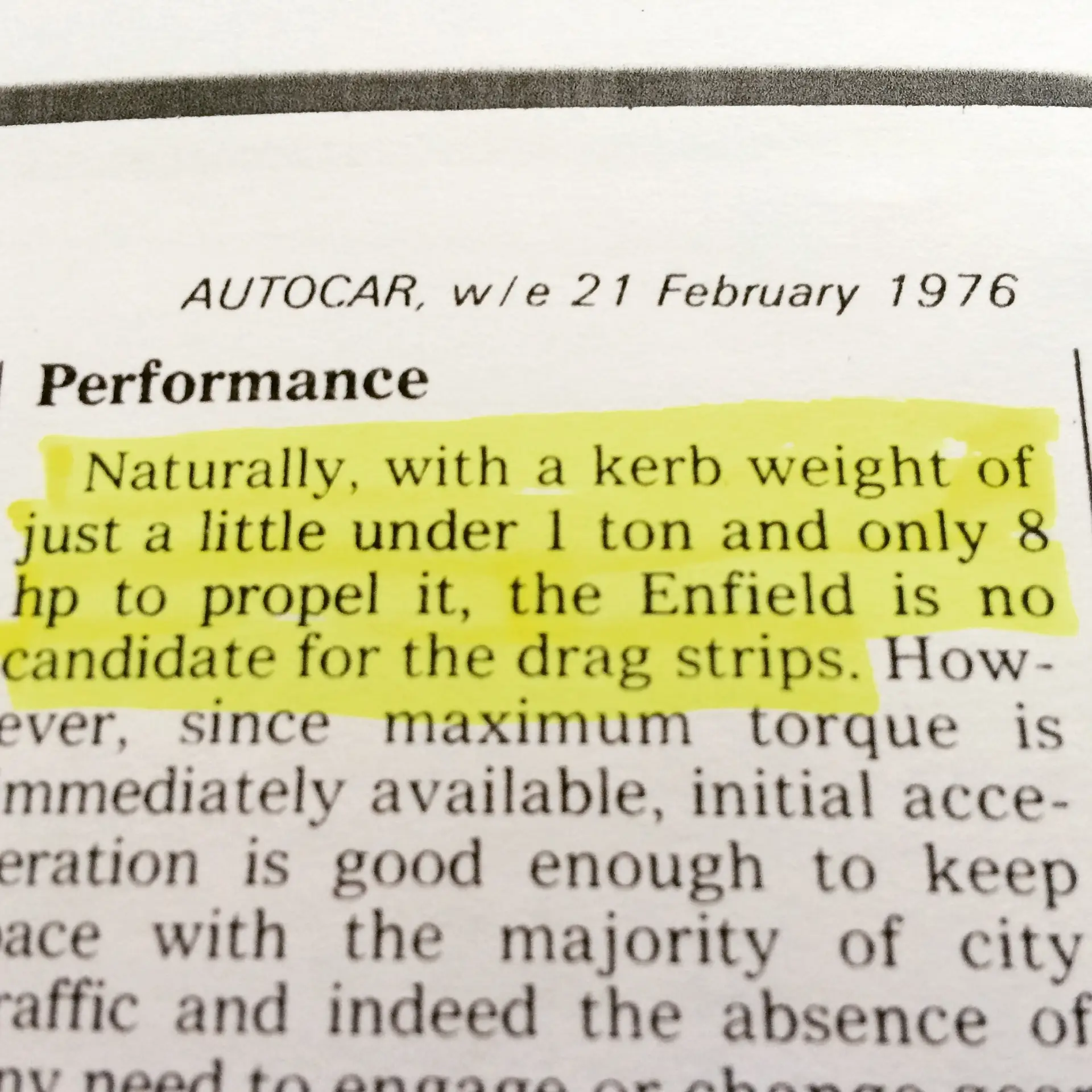

Enfield 8000: A History Lesson
Electric cars aren’t exactly new. Wealthy American ladies were tooling around in EVs in the early 1900s, and those cars only died out when the electric starter motor arrived – deeming petrol powered cars suitable (startable) for even the daintiest-wristed folk. But the idea of BEVs (Battery Electric Vehicles) was heavily revisited when the fuel crisis of 1973 struck. The price of oil barrels quadrupled overnight and suddenly big flash cars didn’t seem so cool anymore. Quirky thrifty cars began to emerge on sale. Enter Great British company Enfield.
![]() Having succeeded in the motorcycle, lawn mower and firearm market, they started developing a new tiny two-seater ECC (Electric City Car) with funding from a Greek tycoon. As you do. The 8000 wasn’t based upon an existing car – it was designed from the ground up primarily as a stumpy urban chariot with an extraordinary turning circle. Like a Smart car, but born quarter of a century earlier. If it looks blimmin tiny, that’s because its wheelbase is over a foot shorter than a Mini’s. Hello crosswinds! Beneath the awkward ’70s Hey-this-is-how-the-future-will-look styling the Enfield follows a similar recipe to race cars: a steel square tubular space frame covered with a lightweight aluminium (slightly Shopmobility looking) bodyshell. It’s as if the styling budget got blown on a huge aircraft style windscreen and streamlined front end (0.29cd for wind tunnel geeks – the same as the 2012 Mercedes SL!), but quickly dried up by the time they reached the set-square back end. Oh dear. But Enfield wisely sniffed around various ’70s car parts bins for consumable parts. So it employs Mini brakes/wheels, mk1 Capri/Allegro headlights, Hillman Imp front suspension and steering, and a Reliant back axle. After buying mine I recognised the exterior doors being identical to our old Hillman Avenger family wagon. It made a little part of my insides flutter. The interior handles have been pilfered from a Morris Marina – thankfully the only Marina part. Apparently the Enfield’s slanted doors are based on Mini panels, but without taking hallucinating drugs I’m failing to see how that can be. The Enfield used a 48-volt DC electric motor inside the transmission tunnel (between the seats) to directly drive the rear wheels. No gearbox. Eight 12v lead acid batteries powered it – four under the bonnet and four in the boot area. An additional battery was used to power stuff like lights, cig lighter, wipers, radio and Bluetooth hands free. OK, the last one was a lie.
Having succeeded in the motorcycle, lawn mower and firearm market, they started developing a new tiny two-seater ECC (Electric City Car) with funding from a Greek tycoon. As you do. The 8000 wasn’t based upon an existing car – it was designed from the ground up primarily as a stumpy urban chariot with an extraordinary turning circle. Like a Smart car, but born quarter of a century earlier. If it looks blimmin tiny, that’s because its wheelbase is over a foot shorter than a Mini’s. Hello crosswinds! Beneath the awkward ’70s Hey-this-is-how-the-future-will-look styling the Enfield follows a similar recipe to race cars: a steel square tubular space frame covered with a lightweight aluminium (slightly Shopmobility looking) bodyshell. It’s as if the styling budget got blown on a huge aircraft style windscreen and streamlined front end (0.29cd for wind tunnel geeks – the same as the 2012 Mercedes SL!), but quickly dried up by the time they reached the set-square back end. Oh dear. But Enfield wisely sniffed around various ’70s car parts bins for consumable parts. So it employs Mini brakes/wheels, mk1 Capri/Allegro headlights, Hillman Imp front suspension and steering, and a Reliant back axle. After buying mine I recognised the exterior doors being identical to our old Hillman Avenger family wagon. It made a little part of my insides flutter. The interior handles have been pilfered from a Morris Marina – thankfully the only Marina part. Apparently the Enfield’s slanted doors are based on Mini panels, but without taking hallucinating drugs I’m failing to see how that can be. The Enfield used a 48-volt DC electric motor inside the transmission tunnel (between the seats) to directly drive the rear wheels. No gearbox. Eight 12v lead acid batteries powered it – four under the bonnet and four in the boot area. An additional battery was used to power stuff like lights, cig lighter, wipers, radio and Bluetooth hands free. OK, the last one was a lie.
The 8000’s electrical guts lived either under the ‘back seat’ storage area or in insulated boxes under the front seats. It features an onboard charger, so you could simply park up and plug in. Or park up and spend 10 minutes reeling out a massive extension lead from the kitchen window. Depending on how angry you mashed the throttle pedal, between 35 and 55 miles could be squeezed from a fully charged Enfield. Knowing only too well how skeptical the British public would be about buying electric, Enfield made a point of extensively testing the 8000’s safety. Although it looks about as trustworthy as a Labrador at an archaeological dig, it was the only electric vehicle of its time to pass British Standard safety tests. And what exactly did that entail? Being flung at 30mph into a solid concrete block. The Enfield 8000 lived from 1973 to ’76. Its small factory in Cowes, Isle of Wight wasn’t what you’d call bustling, managing to build one vehicle per week.
 Depending on where you read, between 108 and 120 were made, with at least half being purchased by the UK Electricity Council for research and pool cars. So why wasn’t it more of a success? Well, it wasn’t shite – the Enfield could do 55 miles on one charge, it was 8″ shorter than a Mini and could top an urbanly brisk 40mph. Its problem was cost.
Depending on where you read, between 108 and 120 were made, with at least half being purchased by the UK Electricity Council for research and pool cars. So why wasn’t it more of a success? Well, it wasn’t shite – the Enfield could do 55 miles on one charge, it was 8″ shorter than a Mini and could top an urbanly brisk 40mph. Its problem was cost.
In 1975 they cost £2,808, which was more than double the windscreen price of a Mini. If you didn’t give a stuff about economy you could walk out of a showroom with a brand new 3-litre Ford Capri for that kind of cash. Thanks to old battery technology the Enfield was a tad heavy too. As a result the 8000ECC faded away into the tapestry of automotive history … which is why I happen to think my surviving example deserves another shot at success.
Albeit this time on a drag track with a roll cage.
ORIGINAL ENFIELD 8000 TECH SPEC
- BODYSHELL: Handbuilt aluminium two-seater
- CHASSIS: Square-section tubular steel space frame
- SUSPENSION: Coil-over McPherson strut front, four-link rear axle
- MOTOR: 8hp / 6kw / 150amps
- BATTERIES: 8 x 12v 55-amp hour lead acid batteries
- TOP SPEED: 40mph
- PERFORMANCE: Erm. Well, 0-30mph in 12.5 seconds
- RANGE: 35-55 miles, depending on climate and quantity of hills
- WEIGHT: 975kg (a lot for such a midget – over 300kg is batteries)
- LENGTH: A mere 2.84m / 112″ (a Mini was 3.05m / 120″)
- WHEELBASE: Just 1.725m / 68″ (a Mini was 2.04m / 80.3″) FUEL: 240v mains Economy Seven



